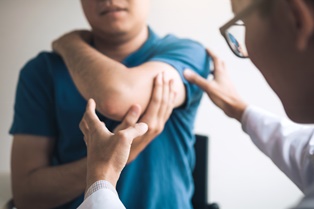Complex regional pain syndrome (CRPS) is a chronic pain syndrome that happens because of a nervous system dysfunction after an injury. It often presents with painful symptoms such as burning and extreme sensitivity in one limb. Some cases are so severe that patients are permanently disabled. 
What Is Complex Regional Pain Syndrome?
This condition is often related to an injury to the peripheral and central nervous systems that occurs after a traumatic force injury—one that might occur during a car crash. The pain a person experiences from CRPS does not necessarily correlate with the pain of the actual injury. Thus, insurance companies tend to believe that if an injury wasn’t severe, the consequences of that injury cannot be severe either. Because of this, it can be difficult to connect CRPS to the accident trauma. But more and more medical experts recognize this condition as real.
In addition to the intense pain and burning feeling that is out of proportion to the injury suffered, other symptoms include:
- Changes to the bone and skin
- Excessive sweating
- Pain and inflammation
- Extreme sensitivity to touch
There are two types of CRPS:
- Type 1. This is most common type of CRPS and is often referred to as reflex sympathetic dystrophy syndrome. With this type, the injury itself does not damage the nerves of the affected limb. It can, therefore, be difficult to prove a link with the injury.
- Type 2. Although symptoms are similar to that of type 1, there is evidence of a nerve injury as a result of the trauma to the limb.
There is no single way to diagnose CRPS, but your physician will conduct an examination and take your medical history to gather clues about your condition. The following diagnostic tests might also be ordered:
- Bone scan to view any changes with your bones
- Sweat production tests that identify uneven sweat amounts on limbs, which could be an indicator of CRPS
- X-rays to detect any loss of minerals in the bones
- Magnetic resonance imaging to view tissue changes that can rule out other conditions
What Treatment Is Available for Complex Regional Pain Syndrome?
Most people find that a combination of treatments might be necessary to relieve the pain and other symptoms of CRPS. Doctors may suggest that patients use the following:
- Over-the-counter pain relievers such as aspirin, ibuprofen, and naproxen sodium for mild pain and inflammation
- Opioid medications for more severe pain
- Antidepressants and anticonvulsants, which sometime help pain that originates from the nervous system
- Corticosteroids to reduce inflammation
- Bone-loss medications to help stall loss of bone that often comes with CRPS
- Sympathetic nerve-blocking medication to relieve pain
Additional therapies can include heat therapy, acupuncture, physical or occupational therapy, or spinal cord stimulation.
What Kind of Legal Compensation Might Be Available After a Diagnosis?
It is not known why some people develop CRPS after a traumatic injury and others don’t. But what experts do know is that more than 90 percent of cases involve symptoms that are triggered by a serious injury.
If you have been diagnosed after a car crash, you may be able to recover damages for:
- Past and future medical expenses
- Lost income
- Medical expenses
- Out-of-pocket costs associated with the injury
- Physical pain
- Emotional suffering
Have You Been Injured in a Virginia Car Accident?
If you've been injured in a car accident, you need to speak with an experienced car accident lawyer as soon as possible. Don’t deal with insurance companies on your own. Their goal is to pay out as little as possible. Getting an experienced lawyer on your side can make all the difference to your recovery and obtaining a fair settlement. Call today to make an appointment for a free consultation.
|
Related links: |

